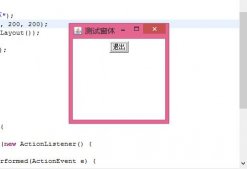本文演示了int、String、数组、list、set、map、Date等属性的注入。
其中Date类型的注入则是借助了Spring提供的属性编辑器来实现的,首先是用到的五个实体类
|
1
2
3
4
5
6
7
8
9
10
11
12
13
14
15
16
17
18
19
20
21
22
23
24
25
26
27
28
29
30
31
32
33
34
35
36
37
38
39
40
41
42
43
44
45
46
47
48
49
50
51
52
53
54
|
package com.jadyer.model; import java.util.Date; import java.util.List; import java.util.Map; import java.util.Set; /** * 常见属性的注入 * @see 包括int,String,Array,list,set,map,Date的注入 */public class Bean11 { private Integer intValue; private String strValue; private String[] arrayValue; private List listValue; private Set setValue; private Map mapValue; private Date dateValue; /* 七个属性的setter和getter略 */ } package com.jadyer.model; public class Bean22 { private Bean33 bean33; private Bean44 bean4422; //注入:与属性名无关,与setBean44()有关 private Bean55 bean55; /* 三个属性的setter和getter略 */ } package com.jadyer.model; public class Bean33 { private Integer id; private String name; private String sex; /* 三个属性的setter和getter略 */ } package com.jadyer.model; public class Bean44 { private Integer id; private String name; private String sex; private Integer age; /* 四个属性的setter和getter略 */ } package com.jadyer.model; public class Bean55 { private String password; /* 关于password的setter和getter略 */} |
然后是我们自定义的java.util.Date类型转换器
|
1
2
3
4
5
6
7
8
9
10
11
12
13
14
15
16
17
18
19
20
21
22
23
24
25
26
27
28
29
30
31
32
33
34
35
36
37
|
package com.jadyer.util; import java.beans.PropertyEditorSupport; import java.text.ParseException; import java.text.SimpleDateFormat; import java.util.Date; /** * java.util.Date属性编辑器。相当于类型转换器。这里是将String转为Date型 * @see ---------------------------------------------------------------------------------------- * @see 该示例主要让大家知道Spring也有这种机制,不是让大家以后写属性编辑器 * @see 需要写属性编辑器的几率太少了,只要知道Spring也有类似的机制就可以了 * @see ---------------------------------------------------------------------------------------- * @see 所谓的属性编辑器,就是将Spring配置文件中的字符串转换成相应的Java对象 * @see Spring内置了一些属性编辑器,也可以自定义属性编辑器 * @see 自定义属性编辑器事,须继承PropertyEditorSupport类并覆写setAsText()方法 * @see 最后再将自定义的属性编辑器注入到Spring中,即可 * @see ---------------------------------------------------------------------------------------- */public class UtilDatePropertyEditor extends PropertyEditorSupport { private String pattern; //将转换的格式放到配置文件中,让Spring注入进来 public void setPattern(String pattern) { this.pattern = pattern; } @Override public void setAsText(String text) throws IllegalArgumentException { System.out.println("======UtilDatePropertyEditor.setAsText()======" + text); try { Date date = new SimpleDateFormat(pattern).parse(text); this.setValue(date); //注意:这里放进去的是一个java.util.Date对象,故输出的时间是默认的格式 } catch (ParseException e) { e.printStackTrace(); throw new IllegalArgumentException(text); //继续向上抛参数非法的异常 } } } |
用到的针对所有实体类的applicationContext-beans.xml文件
|
1
2
3
4
5
6
7
8
9
10
11
12
13
14
15
16
17
18
19
20
21
22
23
24
25
26
27
28
29
30
31
32
33
34
35
36
37
38
39
40
41
42
43
44
45
46
47
48
49
50
51
52
53
54
55
56
57
58
59
60
61
62
63
64
65
66
|
<?xml version="1.0" encoding="UTF-8"?> <beans xmlns="http://www.springframework.org/schema/beans" xmlns:xsi="http://www.w3.org/2001/XMLSchema-instance" xmlns:aop="http://www.springframework.org/schema/aop" xmlns:tx="http://www.springframework.org/schema/tx" xsi:schemaLocation=" http://www.springframework.org/schema/beans http://www.springframework.org/schema/beans/spring-beans-2.5.xsd http://www.springframework.org/schema/aop http://www.springframework.org/schema/aop/spring-aop-2.5.xsd http://www.springframework.org/schema/tx http://www.springframework.org/schema/tx/spring-tx-2.5.xsd" default-lazy-init="true"> <!-- default-lazy-init="true"属性的说明,详见InjectionTest.java类的第49行 --> <!-- default-autowire="byName或byType",这是Spri0ng提供的自动装配bean的两种方式byName和byType,详解略 --> <!-- ***********************【LAZY====延迟初始化】*********************************************************************** --> <!-- 执行testInjection22()时默认的会输出======UtilDatePropertyEditor.setAsText()======2010年06月04日 --> <!-- 即此时并未设置default-lazy-init="true",这说明Bean11中的dateValue属性的值被注入了 --> <!-- 事实上,默认的Spring在创建ApplicationContext时,会将配置文件中所有的对象实例化并进行注入 --> <!-- 这样做的好处是如果Spring配置文件中的某些配置写错了,它立刻就能检测出来 --> <!-- 而Struts1.X的配置文件,如果某个类写错了,是不会出问题的,只有在真正执行的时候,才会出问题 --> <!-- 对于Spring而言,也可以采用相关的属性延迟配置文件的初始化,即default-lazy-init="true" --> <!-- 即只有真正使用的时候,再去New这个对象,再为属性注入。这时就涉及到LAZY,即延迟初始化 --> <!-- 只需修改Spring配置文件即可,如<beans xsi:schemaLocation="http://www...." default-lazy-init="true"> --> <!-- 这时的作用范围即整个配置文件,同理也可对各个<bean>标签的lazy-init属性进行单独配置 --> <!-- 但一般都不会这么设置,而是在BeanFactory创建的时候,即完成注入,这样也便于检查出错误 --> <!-- ***************************************************************************************************************** --> <bean id="bean11" class="com.jadyer.model.Bean11"> <property name="intValue" value="123"/><!-- 注入时,字符串123会自动转换为int型 --> <property name="strValue" value="Hello_Spring"/> <property name="arrayValue"> <list> <value>array11</value> <value>array22</value> </list> </property> <property name="listValue"> <list> <value>list11</value> <value>list22</value> </list> </property> <property name="setValue"> <set> <value>set11</value> <value>set22</value> </set> </property> <property name="mapValue"> <map> <entry key="key11" value="value11"/> <entry key="key22" value="value22"/> </map> </property> <property name="dateValue" value="2010年06月04日"/><!-- 这里Date格式应与applicationContext-editor.xml配置的相同 --> </bean> <bean id="bean22" class="com.jadyer.model.Bean22"> <property name="bean33" ref="bean33"/> <property name="bean44" ref="bean44"/> <property name="bean55" ref="bean55"/> </bean> <bean id="bean55" class="com.jadyer.model.Bean55"> <property name="password" value="123"/> </bean> </beans> |
用到的针对公共实体类的applicationContext-common.xml文件
|
1
2
3
4
5
6
7
8
9
10
11
12
13
14
15
16
17
18
19
20
21
22
23
24
25
26
27
28
29
30
31
32
33
34
35
36
37
|
<?xml version="1.0" encoding="UTF-8"?> <beans xmlns="http://www.springframework.org/schema/beans" xmlns:xsi="http://www.w3.org/2001/XMLSchema-instance" xmlns:aop="http://www.springframework.org/schema/aop" xmlns:tx="http://www.springframework.org/schema/tx" xsi:schemaLocation=" http://www.springframework.org/schema/beans http://www.springframework.org/schema/beans/spring-beans-2.5.xsd http://www.springframework.org/schema/aop http://www.springframework.org/schema/aop/spring-aop-2.5.xsd http://www.springframework.org/schema/tx http://www.springframework.org/schema/tx/spring-tx-2.5.xsd"> <!-- 利用抽象bean提取出公共配置 --> <!-- 首先指定<bean>标签的abstract属性为true,然后在其它<bean>中指定其parent即可 --> <bean id="AbstractBean" abstract="true"> <property name="id" value="2"/> <property name="name" value="张起灵"/> <property name="sex" value="男"/> </bean> <bean id="bean33" class="com.jadyer.model.Bean33" parent="AbstractBean"/> <bean id="bean44" class="com.jadyer.model.Bean44" parent="AbstractBean"> <property name="age" value="26"/> </bean> </beans> <!-- 使用AbstractBean之前的bean33和bean44的原形如下 --><!-- <bean id="bean33" class="com.jadyer.model.Bean33"> <property name="id" value="100"/> <property name="name" value="张三"/> <property name="sex" value="男"/> </bean> <bean id="bean44" class="com.jadyer.model.Bean44"> <property name="id" value="100"/> <property name="name" value="张三"/> <property name="sex" value="男"/> <property name="age" value="90"/> </bean> --> |
用到的针对java.util.Date属性编辑器的applicationContext-editor.xml文件
|
1
2
3
4
5
6
7
8
9
10
11
12
13
14
15
16
17
18
19
20
21
22
23
24
25
26
27
28
29
30
31
32
33
34
35
36
37
38
39
40
41
|
<?xml version="1.0" encoding="UTF-8"?> <beans xmlns="http://www.springframework.org/schema/beans" xmlns:xsi="http://www.w3.org/2001/XMLSchema-instance" xmlns:aop="http://www.springframework.org/schema/aop" xmlns:tx="http://www.springframework.org/schema/tx" xsi:schemaLocation=" http://www.springframework.org/schema/beans http://www.springframework.org/schema/beans/spring-beans-2.5.xsd http://www.springframework.org/schema/aop http://www.springframework.org/schema/aop/spring-aop-2.5.xsd http://www.springframework.org/schema/tx http://www.springframework.org/schema/tx/spring-tx-2.5.xsd"> <bean id="utilDatePropertyEditor" class="com.jadyer.util.UtilDatePropertyEditor"> <property name="pattern" value="yyyy年MM月dd日"/> </bean> <!-- 查看源码得知,在CustomEditorConfigurer类的131行提供了一个setCustomEditors方法,所以就能够注入了 --> <bean id="customEditors" class="org.springframework.beans.factory.config.CustomEditorConfigurer"> <property name="customEditors"> <map> <entry key="java.util.Date" value-ref="utilDatePropertyEditor"/> </map> </property> </bean> </beans> <!-- 也可以使用内部<bean>把utilDatePropertyEditor写在内部 --><!-- 这样就只有它自己有权使用了,外部就无法使用了 --><!-- 由于不提供外界访问,所以内部<bean>没有id属性 --><!-- 示例如下 --><!-- <bean id="customEditors" class="org.springframework.beans.factory.config.CustomEditorConfigurer"> <property name="customEditors"> <map> <entry key="java.util.Date"> <bean class="com.jadyer.util.UtilDatePropertyEditor"> <property name="pattern" value="yyyy年MM月dd日"/> </bean> </entry> </map> </property> </bean> --> |
最后是使用JUnit3.8写的单元测试类
|
1
2
3
4
5
6
7
8
9
10
11
12
13
14
15
16
17
18
19
20
21
22
23
24
25
26
27
28
29
30
31
32
33
34
35
36
37
38
39
40
41
42
43
44
45
46
47
48
49
50
51
52
53
54
55
56
57
58
59
60
61
62
63
|
package com.jadyer.junit; import junit.framework.TestCase; import org.springframework.context.ApplicationContext; import org.springframework.context.support.ClassPathXmlApplicationContext; import com.jadyer.model.Bean11; import com.jadyer.model.Bean22; public class PropertyInjectionTest extends TestCase { private ApplicationContext factory; @Override protected void setUp() throws Exception { /****====读取单一的配置文件====****/ //factory = new ClassPathXmlApplicationContext("applicationContext.xml"); /****====利用数组读取多个配置文件====****/ //这样就会把两个配置文件作为一个来使用,表面上看是作为两个使用的 //其实内部是作为一个使用的,所以在多个配置文件中,里面的id不能重复 //但是name属性可以重复,就好像人的身份证编号和名字的区别是一样的 //String[] configLocations = new String[]{"applicationContext.xml", "applicationContext-editor.xml"}; //factory = new ClassPathXmlApplicationContext(configLocations); /****=====利用 * 匹配模式读取多个配置文件====****/ //业界流行的一句话:约定优于配置 //所以说当有了一个统一的比较好的约定之后,就可以利用框架提供的功能,减少配置量 //另外:如果没有读取到applicationContext-*.xml,此时即便存在applicationContext.xml,它也不会读的 factory = new ClassPathXmlApplicationContext("applicationContext-*.xml"); } /** * 该方法演示的是常见属性的注入,包括int,String,Array,list,set,map,Date的注入 * @see 其中Date类型的注入则是借助了Spring属性编辑器来实现的 */ public void testInjection11() { //Bean11 bean11 = new Bean11(); //若简单的new,那么它的属性是不会被注入的。注入的前提必须是从IoC容器中拿出来的,才会注入 Bean11 bean11 = (Bean11)factory.getBean("bean11"); //此时bean11就是从IoC容器中获取到的,所以它的依赖就会被全部注入 System.out.println("bean11.intValue=" + bean11.getIntValue()); System.out.println("bean11.strValue=" + bean11.getStrValue()); System.out.println("bean11.arrayValue=" + bean11.getArrayValue()); System.out.println("bean11.listValue=" + bean11.getListValue()); System.out.println("bean11.setValue=" + bean11.getSetValue()); System.out.println("bean11.mapValue=" + bean11.getMapValue()); System.out.println("bean11.dateValue=" + bean11.getDateValue()); } /** * 该方法主要演示的是将公共的配置进行抽象,以减少配置量 */ public void testInjection22() { Bean22 bean22 = (Bean22)factory.getBean("bean22"); System.out.println("bean22.bean33.id=" + bean22.getBean33().getId()); System.out.println("bean22.bean33.name=" + bean22.getBean33().getName()); System.out.println("bean22.bean33.sex=" + bean22.getBean33().getSex()); System.out.println("bean22.bean44.id=" + bean22.getBean44().getId()); System.out.println("bean22.bean44.name=" + bean22.getBean44().getName()); System.out.println("bean22.bean44.sex=" + bean22.getBean44().getSex()); System.out.println("bean22.bean44.age=" + bean22.getBean44().getAge()); System.out.println("bean22.bean55.password=" + bean22.getBean55().getPassword()); } } |
以上就是本文的全部内容,希望对大家的学习有所帮助,也希望大家多多支持服务器之家。













